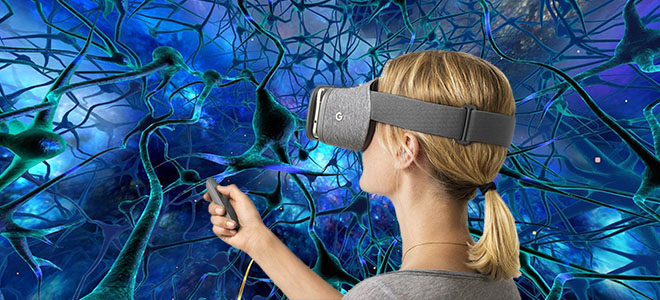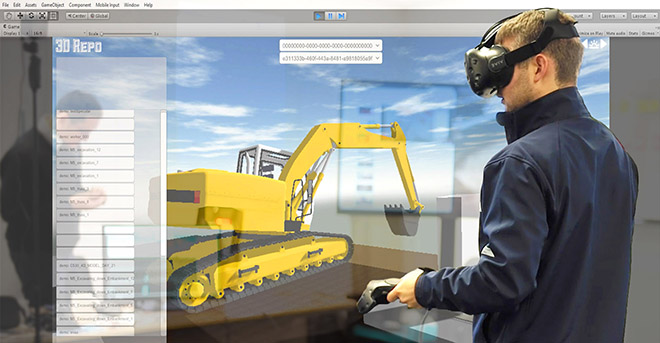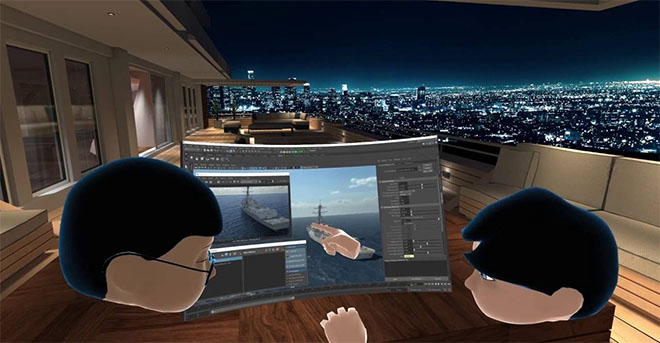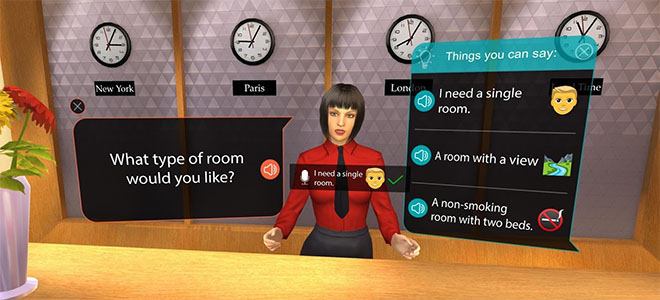How Virtual Reality can Improve Online Learning
Updated February 12, 2021 - Dom Barnard
Virtual reality (VR) has potential to take learning beyond the traditional online learning experience. With benefits such as enhanced engagement, improved retention and experiential learning, this simulation-based technology has the potential to revolutionise how online training programs are performed.
VR educational apps have recently begun entering the main stream market, as several leaders have been looking to use the tech for educational purposes – this, combined with marketing methods of VR companies, such as Kickstarter campaigns, have raised awareness for the industry.

Mobile VR headsets, such as the Google Cardboard, make VR experiences accessible to most people from anywhere they would take traditional online learning, whether it be at home or in the library. VR allows students to visualise concepts that are taught in textbooks and videos.
We're going to be covering everything, from the current state to online learning, to the role social VR will play, to the future of an online education system integrated with virtual reality.
Current state of online learning
What is online learning?
In a traditional classroom or lecture, you learn by listening to your teacher and talking to classmates. There is usually a specific time and location for these classes. With online learning however, you can be anywhere in the world and still receive the same high quality teaching as someone who is there in person.
Online learning is typically conducted through the internet, as a series of courses you can access anytime, anywhere. Socializing and asking questions is done through discussion forums or via email.
Why is online learning growing?
Online learning offers a number of advantages for students wanting to learn new skills or educate themselves – the key one being that they can access this educational material from anywhere, at any time.

Although many people still consider traditional universities, schools or classes as the best way to educate themselves, online learning proves to be a great alternative or supplementary tool.
Key benefits of online learning include:
- Lower total costs - online programs can be a more affordable option than traditional learning institutions. Though not all online degrees have less expensive tuition prices than traditional colleges or universities, associated costs are almost always less expensive when considering commuting and accommodation.
- Variety of programs and courses – students learning online already have a huge variety of courses and instructors they can learn from. Whatever students want to learn, from mechanical engineering to neuroscience to running a business, they can find the online learning courses or classes they need.
- Avoid commuting or relocating – students can save of travel and living expenses, as well as commuting time by learning online. Student accommodation for regular college or university can be very expensive and avoided when learning online.
- Convenience and flexibility - access to all resources at any time lets participants learn wherever they are, leaving them the freedom to choose the time for study. Students can study and work when they are at their peak energy, whether that’s early morning or late at night.
- Immediate results and feedback – online quizzes and interactive experiences can be graded immediately, giving you areas you need to improve without any delay. Waiting for human feedback can take weeks or even months.
- Access to the best teachers - in any country, there are only a handful of experts in every field of study. Take away the limitations of geography, and expertise is free to travel anywhere. This transformation allows information on highly specialized subjects to reach more people, paving the way for advances in fields from robotic control theory to corporate leadership.
Barriers to learning online
There is plenty of positive information about an online education with some very obvious advantages. However, most students are still choosing traditional classes - why is this? There are still several big drawbacks to online education in comparison to traditional classroom education.

1. Lack of accreditation
Few online classes are accredited by established institutions, which is important if people are taking these online classes for a potential new job or resume / CV boost. However this is gradually changing, with large sites offering their own certificates of completion (FutureLearn and Coursera) and companies starting to see students who have completed online courses as a positive, even without accreditation.
2. You need to be self-disciplined
Online courses usually have deadlines for assignments, quizzes, commenting on lectures, etc. The problem is the time management and organization skills necessary to stay on top of your work, allot an appropriate amount of time to complete each task and balance your coursework against other priorities in your life. Students who tend to procrastinate find online courses hard to work through and complete.
3. Low retention and completion rates
Due to the low cost of online courses and training programs, there is less incentive to complete them and large course sites have noticed very few students actually make it to the end. Besides cost, few of these online courses have accreditation for them, further reducing the incentive to finish them. Some students might indeed only need to learn about certain topics on the course and therefore never intend to complete the whole of it, but for the majority of students this is not the case.
4. Require good time-management skills
Online courses require the self-discipline to set aside time to complete your studies. It means you have to make online studying a priority and not let other activities interfere.
5. Lacks the social aspect of regular classes
The social aspect of regular classes is an important part of learning and improving soft skills. Getting stuck on problems and asking classmates, group work and other group based activities help people learn more efficiently and provide a collaborative environment similar to a company workspace. It’s hard to recreate this social aspect with online learning.
What is virtual reality?
Overview
Virtual reality is the term used to describe a three-dimensional, computer generated environment which can be explored and interacted with by a person. That person becomes part of this virtual world or is immersed within this environment and whilst there, is able to manipulate objects or perform a series of actions to determine what happens in the environment.

Virtual reality usually has these characteristics:
- Believable - You feel like you're in your virtual world through what you see and hear.
- Immersive - As you move your head around, what you see changes as well, just as it would in real life.
- Computer-generated - VR worlds are usually created with complex 3D computer graphics that change in real time as we move.
- Interactive - You can interact with different objects in the scene, whether it’s pressing a button or opening a door.
Read more about VR in our Complete Guide to Virtual Reality
How can online learning benefit from VR?
Learn experientially for effective learning
Experiential learning is a process of learning through first-hand experience. It’s a method of gaining expertise and skills through the practical application of concepts, theories and problem solving techniques instead of just reading or hearing about them.

The Hermann Ebbinghaus forgetting curve roughly says that during a traditional lecture, if your absorption rate is at 100 percent on day one, there is a 50-80 percent loss of learning from the second day onward, which is reduced to a retention rate of just 2-3 percent at the end of thirty days. Experiential learning increases this retention rate considerably.
VR lets you learn experientially by immersing you to any world imaginable – walk with dinosaurs in the Jurassic Period, live through Stalingrad during WW2, practice a heart operation on a virtual avatar, talk to a press room full of journalists – the use cases are endless.
Here are some of the benefits of experiential learning with VR:
- Accelerates learning - repetitive learning or learning by rote can be dramatically improved by actually performing or visualising the learning material. VR learning uses problem solving, powerful visualisation, decision making and other elements to enhance the learning experience.
- Provides a safe learning environment - it is only natural that mistakes happen during the course of learning, and using VR simulations lets people learn in a safe controlled environment. Students can therefore try different approaches and understand for themselves what works best.
- Bridges the gap between theory and practice - students often learn textbook theory about a certain topic, experiencing this theory in an interactive 3D environment gives students a more memorable learning experience.
- Increases engagement levels - the virtual world lets students collaborate and learn from each other, increasing overall engagement with a tangible outcome result.
- Assessing complex learning is easier - VR can simulate a range of complex topics, from brain surgery to gravity, bringing the learning process to life.

Practice and visualise virtually anything, from anywhere
Just like traditional online learning, VR can be used anywhere with an internet connection. You can practice public speaking, experience walking through Ancient Rome or teleport inside a brain cell – all form the comfort of your own home.
Social VR is very important
The importance of social and collaborative learning
Whether it’s getting the job, building your network, or just interacting with customers, knowing how to interact with the people around you is an important element to success and can be improved by spending time with other people.
Lack of contact with other people can also harm your intellectual development. A BBC article about the impact of antisocial shift work on the human mind shows that when you’re in isolation and working long hours, you can lose memory, speed of thought and wider cognitive ability.
This is big negative of traditional online learning, there are discussion forums where you can e-meet and talk with other people, but you still miss the connection of a face to face interaction. Virtual reality goes some way to changing this – you can meet other people’s avatar in a virtual world, where elements such as eye contact and body language are still important.

Benefits of learning in a collaborative VR environment compared to traditional online learning include:
- Tolerant of diversity - as people from anywhere in the world can meet in the same virtual space with their avatars, there will be a huge amount of diversity. Students will learn to work with all types of people in a range of group based activities, getting very different perspectives on a range of topics taught in that class.
- Acknowledgment of individual differences - when questions are raised in the virtual class, different students will have a variety of responses. There will help create a learning environment which reflects a wide range of perspectives.
- Actively involving students - each member has opportunities to contribute in small groups. Students are apt to take more ownership of their material and to think critically about related issues when they work as a team.
- More opportunities for personal feedback - because there are more exchanges among students in groups, your students receive more personal feedback about their ideas and responses.
The current state of social in virtual reality
Social VR allows you to meet other students virtually, in much the same way you would in real life. You can do homework together (Bigscreen), travel around the world during the holidays (Facebook Horizon) and even attend classes together (Engage).
Combining the social aspects of current VR applications with educational programs lets students get a somewhat similar experience to actually attending classes and completing group work with other students.
VirtualSpeech for Education
Discover why universities and colleges are using the VirtualSpeech VR app to enhance the learning experience of their students.
Download eBookExamples of VR currently being used in learning online
Here are some examples of how VR is currently being used in the educational industry. Companies are using VR as a standalone learning experience and also combining VR with traditional online learning courses.
Sales Pitch and Closing course
This sales pitching course combines traditional online classes with virtual reality for an enhanced learning experience. You’ll learn fundamental sales pitching skills and then practice what you've learnt in VR and receive feedback on your performance.
- Learn more about the course: Sales Pitch and Closing course
Engage classroom
This VR learning platform puts you in a virtual lecture or classroom with other virtual students, where you can watch lectures from leading teachers from around the world. Teachers can spawn objects into the lecture room, such as a skeleton or whale, to bring to life what they are describing.
- Learn more about Engage: Engage platform
Public speaking and storytelling
This hybrid public speaking course combined classes and VR, giving you an opportunity to practice what you learn. For example, you'll watch videos and read about how to give eye contact to different sized audiences, then get the chance to practice this in VR in front of virtual avatars in realistic conference and meeting rooms.
- Learn more about the course: Essential Public Speaking with VR
Visit Ancient Rome with Unimersiv
Unimersiv lets you travel to Ancient Rome and wonder the streets with a guided tour of the city. This is a great example of how VR and improve history by bringing ancient cities and locations to life.
- Learn more about Unimersiv: Unimersiv platform

Future of online education and VR
From supplementary to entire learning experience
Currently online learning is mostly constrained to learning a useful skill (Udemy, CreativeLive), completing several lectures (Coursera) or improving areas of your existing knowledge (Pluralsight).
There are some longer, more in depth learning experiences (e.g. Udacity self-driving car course), however the majority of online learning does not replace traditional in person learning.
As VR improves, whole curriculum and degrees will be built within virtual environments, where you attend lectures virtually while retaining the collaborative learning experience with other students. This immersive form of learning has many advantages, for example being in a virtual chemistry lesson and the lecturer spawning a molecule or showing a chemical reaction virtually in that classroom.

Example future scenarios
Here are examples of how online degrees might look with virtual reality integrated into them.
1. Virtual aeronautical engineering degree
- Online discussion forums - ask questions and find answers about problems you are struggling to solve.
- Online video tutorials - the bulk of the learning content would be available in the usual online video format
- VR based lectures - when explaining concepts where a physical object would help, such as explaining the composition of an aircraft engine or how air flows over a wing, students could enter a virtual lecture to watch the professor explain these concepts with the aid of a virtual engine.
- VR study groups - when you’ve got group project to do, teams could meet in the virtual world to discuss ideas and develop solutions.
2. Virtual language learning degree

- Online discussion forums - ask questions and find answers about the language and culture you are trying to learn.
- Online video tutorials - the bulk of the learning content would be available in the usual online video format
- VR based roleplay - learning English? Travel to a hotel in London to practice booking a hotel room, or visit Bristol to practice booking a meal at a restaurant. VR allows students to practice their oral and listening skills in the country of the language they are trying to learn.
- VR cultural immersion - learning French? Visit historic sites and landmarks virtually all around France.
- VR social meetups - practice speaking the language you are learning with other beginners or experienced coaches in virtual rooms and locations.

